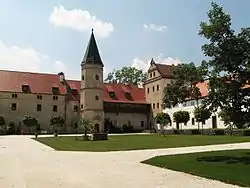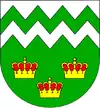Libouchec
Libouchec (German: Königswald) is a municipality and village in Ústí nad Labem District in the Ústí nad Labem Region of the Czech Republic. It has about 1,800 inhabitants.
Libouchec | |
|---|---|
 Libouchec Castle | |
 Flag  Coat of arms | |
 Libouchec Location in the Czech Republic | |
| Coordinates: 50°45′31″N 14°2′27″E | |
| Country | |
| Region | Ústí nad Labem |
| District | Ústí nad Labem |
| First mentioned | 1169 |
| Area | |
| • Total | 28.01 km2 (10.81 sq mi) |
| Elevation | 336 m (1,102 ft) |
| Population (2020-01-01[1]) | |
| • Total | 1,805 |
| • Density | 64/km2 (170/sq mi) |
| Time zone | UTC+1 (CET) |
| • Summer (DST) | UTC+2 (CEST) |
| Postal code | 400 02, 403 35, 403 36 |
| Website | www |
Libouchec lies approximately 12 kilometres (7 mi) north of Ústí nad Labem and 80 km (50 mi) north of Prague.
Geography
Libouchec is situated in the valley of Jílovský brook, which separates České Středohoří and the Elbe Sandstone Mountains.
History
Already in the 10th and 11th century were established two fortresses (in today's Jílové and in Libouchec). Later, in the 13th century, was established around this royal stronghold new village Libouchec. Its original name was Regis Silva (Königswald). But the first official mention was in a chronicle in 1169. The first settlers were Celts and Germanics, from the 5th century initially mainly Slavic peoples and from the late Middle Ages onwards mainly Germans. After World War II almost the entire population of the town was expropriated without compensation and expelled due to their German ethnicity. Libouchec was mainly resettled with Czechs, Slovaks and Roma.
There was a important Salt trail through Libouchec. Salt was carrying from here to Děčín where it was embarked and sent to inland. There started an important production in manufacture in the end of feudalism (buttons, textile, primitive machines). The nobility from Bynov began in the 16th century with logging, mining of ore and silver. In the 19th century was its surroundings industrial region. There began the production of velvet, liqueurs, mustard and agricultural machines.
Important was also the railway which has led from Duchcov to Děčín. It was built in 1869 by Mr. Zacharias and was the most expensive railway being built at that time. Unfortunately the running of it was canceled in 2008.
Sights
The most significant buildings in Libouchec are The Church of the Three St. Kings and the castle. The church was built in 1357, but after burning out it was repaired in the 16th century and from that time has been rebuilt many times. The castle (its original name was Schönstein) was established by Günter from Bünau in the 16th century. From that time the castle has weathered much (the Thirty Years' War, fires...) and it has been in the emergency conditions. In 2003 the castle was sold and has since been repaired.
References
- "Population of Municipalities – 1 January 2020". Czech Statistical Office. 2020-04-30.
| Wikimedia Commons has media related to Libouchec. |